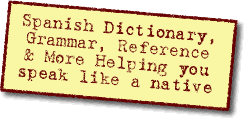Ask a Question(Create a thread) |
|
|||||||
Direct / indirect objectThis is the place for questions about conjugations, verb tenses, adverbs, adjectives, word order, syntax and other grammar questions for English or Spanish. |
 |
|
|
Thread Tools | Display Modes |
|
#1
|
||||
|
||||
|
Direct / indirect object
Hello Can somebody help me about direct and indirect objects and how to use them in spanish. Thank you
|
|
Get rid of these ads by registering for a free Tomísimo account.
|
|
#2
|
||||
|
||||
|
I saw the dress and wanted to buy it.
Vi al vestido y quise comprarlo. OR Vi al vestido y quise lo comprar. ^^ I might have done this wrong *shrug* More threads with indirect and direct objects <<< This might help you 
Last edited by Jessica; September 27, 2009 at 11:34 AM. |
|
#3
|
||||
|
||||
|
Quote:
In the example that you've made here Jessica, I'd like comment that it will sound better if you write that in the following way. He visto el vestido y quise comprarlo. Even although you example is correctly written, but anyhow, I don't know, I'd like suggesting you saying it in another way. Sincerely yours.
__________________
We are building the most important dare for my life and my family feature now we are installing new services in telecoms. 
|
|
#4
|
||||
|
||||
|
Quote:
 Here are some links that will help you: IOPs & DOPs IOP/DOP Sentences Le, Lo, and La, Oh my! |
|
#5
|
||||
|
||||
|
Direct Object: just for starting, you can distinguish it by asking the verb “what?”. Its not useful for every sentence, just for simple sentences (the best form would be to transform into passive voice or you can substitute the nouns by pronouns). Pronouns have already been mentioned.
Indirect Object: answers the question “¿a quién? / ¿para quién? I insist: it’s just for starting and for simple sentences. A simple sentence as: Voy a comprar ese vestido para mi sobrina (ese vestido –DO-; para mi sobrina –IO-) ¿Qué voy a comprar? – DO = ese vestido ¿a / para quién lo compro? – IO = para mi sobrina Pronouns: Voy a comprarlo para mi sobrina (lo = DO) Se lo voy a comprar (se = IO –“le” is transformed here into “se” to avoid cacophony, but remember that “se” can have other functions) Passive voice: El vestido (DO is transformed into subject) es comprado por mí para mi sobrina (IO) Position of pronouns: IO + DO + V Se lo voy a comprar V + IO + DO Voy a comprárselo Duplication of the IO: Se lo voy a comprar para mi sobrina. Voy a decirles esto a mis compañeros (look the concordance pronoun and IO) And about the sentence “vi el vestido”, remember that with some verbs some propositions are required in some occasions. For instance, with “ver” you must use the preposition “a” with persons and some animals you know (for instance a pet). Even if they use the preposition “a”, they’re still DO: Vi a tu hermana la semana pasada (yo la vi, tu hermana fue vista por mí) Vi a tu perro el día que se perdió. Vi la oveja del vecino. Vi el vestido en el escaparate. |
|
#6
|
||||
|
||||
|
Quote:
good explanation 
|
|
#7
|
||||
|
||||
|
muchas gracias
|
 |
| Tags |
| direct object, do, indirect object, io, objects |
«
Previous Thread
|
Next Thread
»
| Link to this thread | |
|
|
|||||||
 Similar Threads
Similar Threads
|
||||
| Thread | Thread Starter | Forum | Replies | Last Post |
| Using Indirect and Direct Object Pronouns Together | Elizabeth | Grammar | 3 | August 13, 2009 10:09 AM |
| Indirect object | cmon | Grammar | 1 | February 12, 2009 04:13 PM |
| direct and indirect object pronouns | gramatica | Vocabulary | 2 | January 16, 2008 05:27 PM |
| direct object pronouns and indirect object pronouns | Twitchy11 | Grammar | 3 | September 29, 2007 11:37 AM |
All times are GMT -6. The time now is 10:28 PM.









 Linear Mode
Linear Mode

